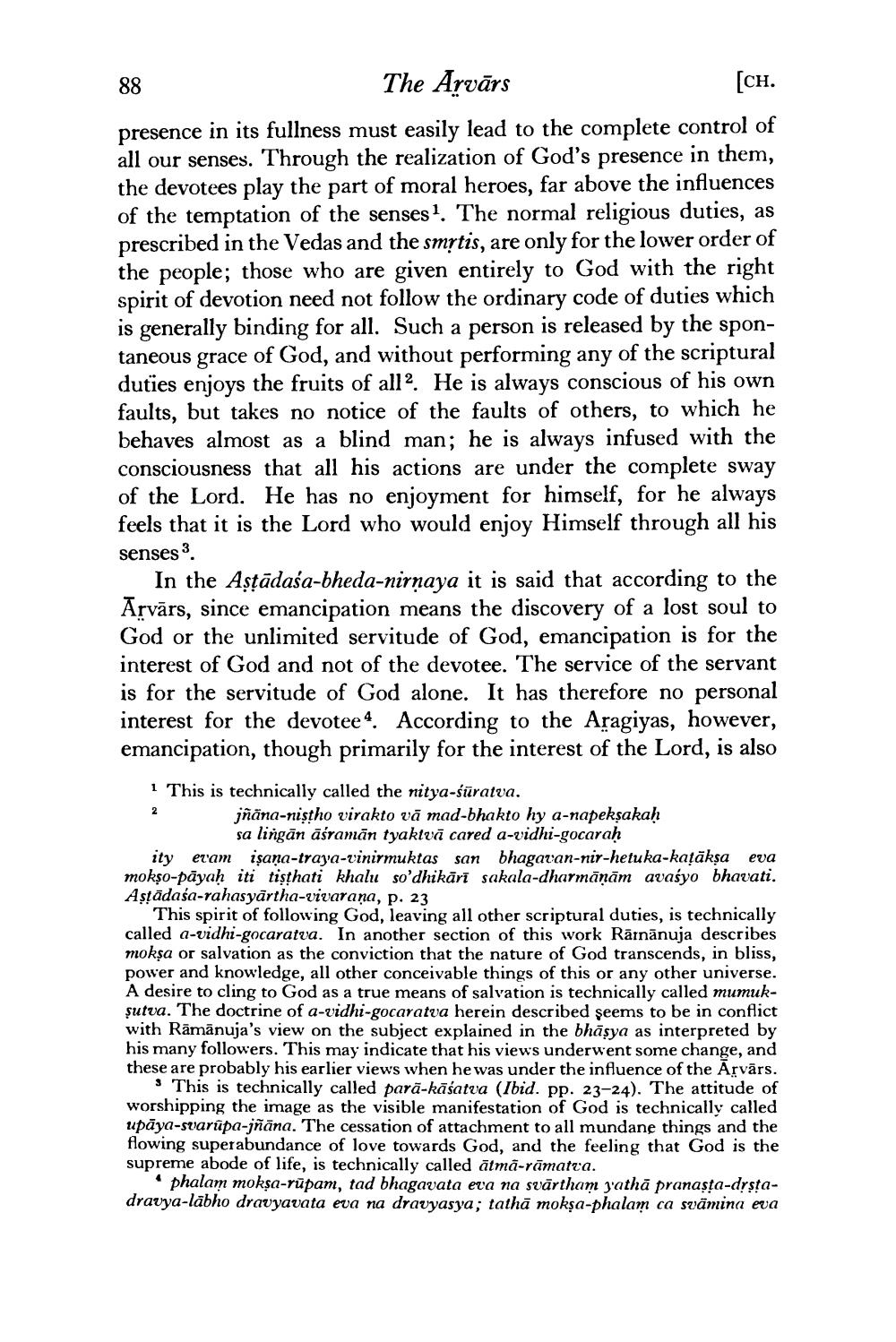________________
The Arvārs
[CH.
presence in its fullness must easily lead to the complete control of all our senses. Through the realization of God's presence in them, the devotees play the part of moral heroes, far above the influences of the temptation of the senses1. The normal religious duties, as prescribed in the Vedas and the smṛtis, are only for the lower order of the people; those who are given entirely to God with the right spirit of devotion need not follow the ordinary code of duties which is generally binding for all. Such a person is released by the spontaneous grace of God, and without performing any of the scriptural duties enjoys the fruits of all2. He is always conscious of his own faults, but takes no notice of the faults of others, to which he behaves almost as a blind man; he is always infused with the consciousness that all his actions are under the complete sway of the Lord. He has no enjoyment for himself, for he always feels that it is the Lord who would enjoy Himself through all his senses 3.
88
In the Aṣṭādasa-bheda-nirnaya it is said that according to the Ārvārs, since emancipation means the discovery of a lost soul to God or the unlimited servitude of God, emancipation is for the interest of God and not of the devotee. The service of the servant is for the servitude of God alone. It has therefore no personal interest for the devotee. According to the Aragiyas, however, emancipation, though primarily for the interest of the Lord, is also
1 This is technically called the nitya-suratva.
2
jñāna-nişṭho virakto vā mad-bhakto hy a-napekṣakaḥ sa lingan asraman tyaktvā cared a-vidhi-gocaraḥ
ity
eva
iṣaṇa-traya-vinirmuktas san bhagavan-nir-hetuka-kaṭākṣa mokṣo-pāyaḥ iti tisthati khalu so'dhikārī sakala-dharmāņām avaśyo bhavati. Aṣṭādasa-rahasyartha-vivaraṇa, p. 23
This spirit of following God, leaving all other scriptural duties, is technically called a-vidhi-gocaratva. In another section of this work Rainanuja describes mokşa or salvation as the conviction that the nature of God transcends, in bliss, power and knowledge, all other conceivable things of this or any other universe. A desire to cling to God as a true means of salvation is technically called mumukşutva. The doctrine of a-vidhi-gocaratva herein described şeems to be in conflict with Ramanuja's view on the subject explained in the bhasya as interpreted by his many followers. This may indicate that his views underwent some change, and these are probably his earlier views when he was under the influence of the Arvars. This is technically called para-kāśatva (Ibid. pp. 23-24). The attitude of worshipping the image as the visible manifestation of God is technically called upaya-svarupa-jñāna. The cessation of attachment to all mundane things and the flowing superabundance of love towards God, and the feeling that God is the supreme abode of life, is technically called ātmā-rāmatva.
phalam mokṣa-rupam, tad bhagavata eva na svartham yatha pranasta-dṛṣṭadravya-labho dravyavata eva na dravyasya; tatha mokṣa-phalam ca svämina eva
eram




